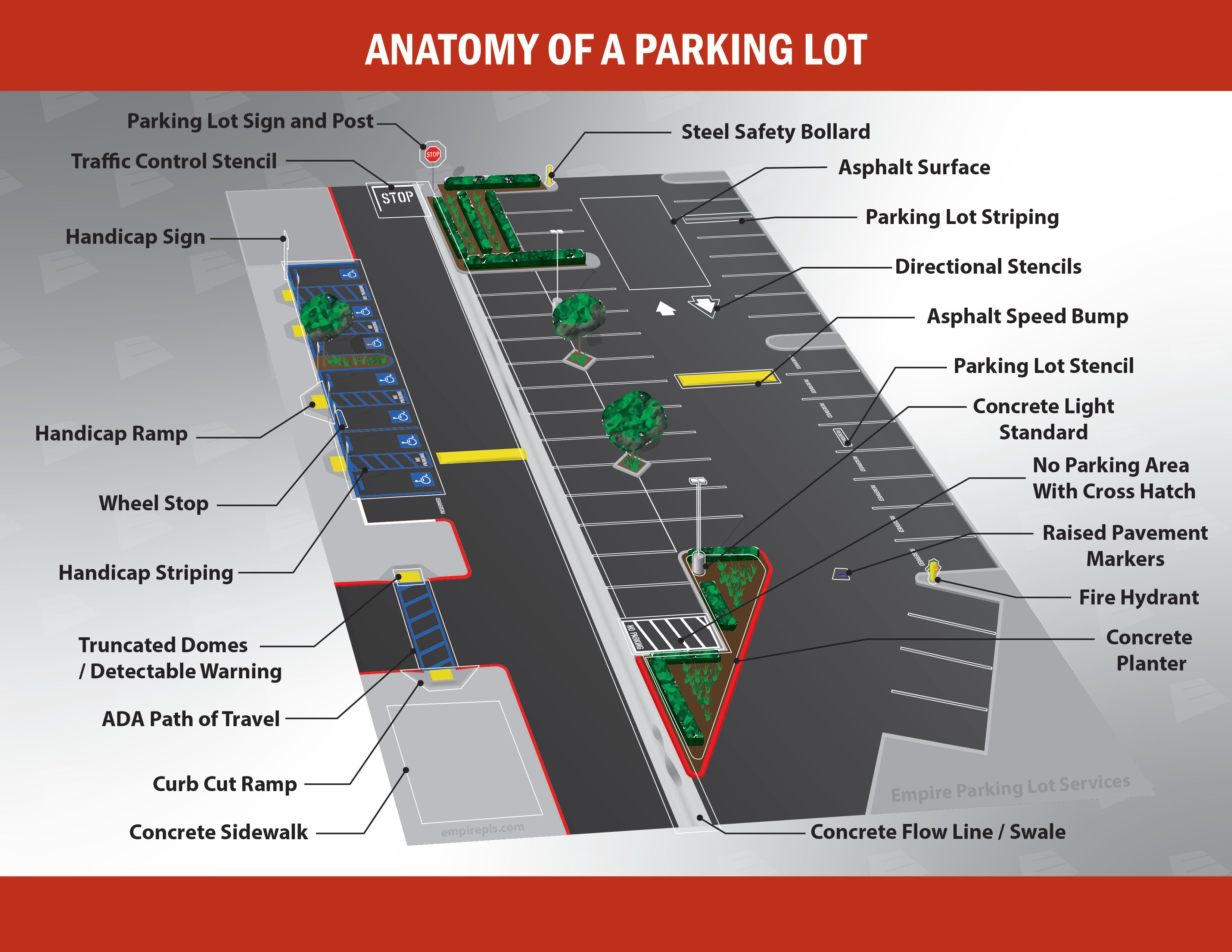Everyone is familiar with the large area of asphalt that makes up a parking lot, but there are many other elements that go into a well-designed lot as well. Many of these are just as familiar as the asphalt itself. Others might be afterthoughts that the average person does not immediately think of when considering parking lot construction. In this post, we'll go over many of the common elements that make up a parking lot.
Flow Control Elements
- Parking Lot Signs and Posts - Almost every parking lot has at least a stop sign located somewhere to control the flow of traffic. Large ones may have multiple stop signs that guide traffic from the road and into the parking lot or vice-versa.
- Traffic Control Stencils - A wide variety of stencils make up the markings of a parking lot. Traffic control stencils are the ones that appear near the traffic control signs. These are the stencils that mark the word STOP clearly on the asphalt to help ensure that the stop sign is not missed.
- Directional Stencils - Directional stencils are arrows or other markings that help direct the flow of traffic in the correct direction to ensure that things run smoothly in a busy parking lot.
- Parking Space Stencils - Parking space stencils can be used to notify drivers when a certain space is reserved for a certain person or group of people.
- Parking Space Striping - Stripes are familiar to everyone. They are the lines that mark off the boundaries between parking spaces.
- No Parking Area Markers - Crosshatch markings indicating areas which should not be parked in can be used to keep traffic moving without unwanted blockage, or for safety reasons.
Safety Features
- Safety Bollards - Safety bollards are large posts used to either clearly mark potential obstacles or to prevent vehicles from crashing into property and causing damage. As permanent fixtures, they are usually steel filled with concrete. Safety bollards are often seen in front of buildings to prevent drivers from crashing into them.
- Wheel Stops - Wheel stops are barriers at the front of a parking space that will gently stop a car if it tries to pull too far into the spot. They are used to prevent vehicles from bumping into one another. Wheel stops can be made of concrete, plastic, or rubber.
- Speed Bumps - Parking lots have a high level of pedestrian traffic. This makes speeding through them especially dangerous. Speed bumps can be used to ensure that drivers slow down, particularly in areas where pedestrians are likely to travel.
- Light Standards / Light Poles - Visibility is important as pedestrians make their way to and from their vehicles. Once their headlights are turned off, they should still have enough light to see. Ample light in the parking lot is provided by properly spaced light standards.
- Raised Pavement Markers - These markers, placed in the line of traffic, have reflective surfaces that help to improve visibility when poor weather makes it difficult for drivers to see. They can also be used to help draw attention to important features such as fire hydrants, or areas that are closed off for drivers.
- Curb Cut Ramps - These are the ramps that you see cut into the curb as you cross the street onto the sidewalk that leads into a building or to another walkway. They are designed to minimize the chance of someone tripping and falling into traffic. They also function as an accessibility feature for people in wheelchairs or with other difficulties walking.
Handicapped Parking Elements
- Handicap Signs - Parking spaces reserved for people with disabilities are required by most states to have signage indicating that they are designated for that use. Some states, including California, require an additional sign that notifies drivers of the $250 fine if they park in the spot illegally.
- Handicap Striping - Handicap parking spaces are often wider than traditional parking spaces. The extra width allows wheelchairs to easily maneuver in the space. Some parking spaces have even greater space between them to allow for vans to load and unload the wheelchair or motorized scooters easily. These spaces are often filled with cross-hatch to prevent people from parking in them.
- Handicap Ramps - These are the same as curb cut ramps, except that they are placed near the handicap designated parking spots. Here, rather than serving as mainly a safety feature, they serve as an accessibility feature to ensure that people in wheelchairs can easily get onto the sidewalk.
- ADA Path of Travel Markers - These are essentially the same as crosswalks. They indicate where the designated spots for pedestrian traffic are so that both pedestrians and drivers are aware of the potential safety hazard. ADA path of travel markers will also be between ramps where needed to ensure accessibility for everyone.
- Truncated Domes / Detectable Warnings - Truncated domes are used whenever the walking surface changes. They are often found in curb cut ramps. They are to ensure that people impaired vision can see that a change in the surface is coming so they don't unexpectedly trip up or losing their footing.
Additional Features
- Concrete Sidewalks - There is usually a concrete sidewalk in front of buildings, but they can also be placed in busy parking lots to provide pedestrians with a more secure place to walk.
- Concrete Planters - Concrete planters can serve as a special kind of curb that allows landscapers to plant trees or other foliage to improve the look of the parking lot. They often also serve the dual function of helping to bring separation to the parking lot, thereby improving traffic flow.
- Concrete Flow Line / Swale - Concrete flow lines may be placed in a parking lot to help control the flow of water runoff after wet weather. They help to protect the asphalt and minimize potentially hazardous standing water on the parking lot.
Bringing it all Together
A lot of work and expertise goes into properly planning out the placement of these elements. There are often legal requirements that must be followed. Each of these elements also has proper maintenance procedures to ensure that they have the longest life possible and to provide prompt repairs should damage cause them to become a hazard. At Empire Parking Lot Services, we have the experience to serve all of your parking lot needs. If you are in need of parking lot repair or planning, we invite you to call us at 714-633-0300. One of our experienced team members will be glad to answer any questions you may have and get you started on a prompt quote for any work needed. Please check out our "Anatomy of a Parking Lot" blog for a more in-depth view of what makes up a parking lot.





Comments